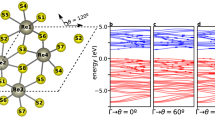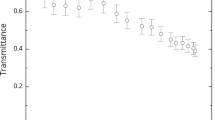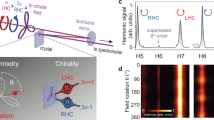Abstract
High-harmonic (HH) generation in crystalline solids1,2,3,4,5,6 marks an exciting development, with potential applications in high-efficiency attosecond sources7, all-optical bandstructure reconstruction8,9 and quasiparticle collisions10,11. Although the spectral1,2,3,4 and temporal shape5 of the HH intensity has been described microscopically1,2,3,4,5,6,12, the properties of the underlying HH carrier wave have remained elusive. Here, we analyse the train of HH waveforms generated in a crystalline solid by consecutive half cycles of the same driving pulse. Extending the concept of frequency combs13,14,15 to optical clock rates, we show how the polarization and carrier-envelope phase (CEP) of HH pulses can be controlled by the crystal symmetry. For certain crystal directions, we can separate two orthogonally polarized HH combs mutually offset by the driving frequency to form a comb of even and odd harmonic orders. The corresponding CEP of successive pulses is constant or offset by π, depending on the polarization. In the context of a quantum description of solids, we identify novel capabilities for polarization- and phase-shaping of HH waveforms that cannot be accessed with gaseous sources.
This is a preview of subscription content, access via your institution
Access options
Access Nature and 54 other Nature Portfolio journals
Get Nature+, our best-value online-access subscription
$29.99 / 30 days
cancel any time
Subscribe to this journal
Receive 12 print issues and online access
$209.00 per year
only $17.42 per issue
Buy this article
- Purchase on Springer Link
- Instant access to full article PDF
Prices may be subject to local taxes which are calculated during checkout




Similar content being viewed by others
References
Ghimire, S. et al. Observation of high-order harmonic generation in a bulk crystal. Nat. Phys. 7, 138–141 (2011).
Schubert, O. et al. Sub-cycle control of terahertz high-harmonic generation by dynamical Bloch oscillations. Nat. Photon. 8, 119–123 (2014).
Luu, T. T. et al. Extreme ultraviolet high-harmonic spectroscopy of solids. Nature 521, 498–502 (2015).
Vampa, G. et al. Linking high harmonics from gases and solids. Nature 522, 462–464 (2015).
Hohenleutner, M. et al. Real-time observation of interfering crystal electrons in high-harmonic generation. Nature 523, 572–575 (2015).
Ndabashimiye, G. et al. Solid-state harmonics beyond the atomic limit. Nature 534, 520–523 (2016).
Ghimire, S. et al. Generation and propagation of high-order harmonics in crystals. Phys. Rev. A 85, 043836 (2012).
Vampa, G. et al. All-optical reconstruction of crystal band structure. Phys. Rev. Lett. 115, 193603 (2015).
Garg, M. et al. Multi-petahertz electronic metrology. Nature 538, 359–363 (2016).
Zaks, B., Liu, R. B. & Sherwin, M. S. Experimental observation of electron–hole recollisions. Nature 483, 580–583 (2012).
Langer, F. et al. Lightwave-driven quasiparticle collisions on a subcycle timescale. Nature 533, 225–229 (2016).
Higuchi, T., Stockman, M. I. & Hommelhoff, P. Strong-field perspective on high-harmonic radiation from bulk solids. Phys. Rev. Lett. 113, 213901 (2014).
Eckstein, J. N., Ferguson, A. I. & Hänsch, T. W. High-resolution two-photon spectroscopy with picosecond light pulses. Phys. Rev. Lett. 40, 847–850 (1978).
Udem, Th., Holzwarth, R. & Hänsch, T. W. Optical frequency metrology. Nature 416, 233–237 (2002).
Cundiff, S. T. & Ye, J. Colloquium: femtosecond optical frequency combs. Rev. Mod. Phys. 75, 325–342 (2003).
Holzwarth, R. et al. Optical frequency synthesizer for precision spectroscopy. Phys. Rev. Lett. 85, 2264–2267 (2000).
Bartels, A., Heinecke, D. & Diddams, S. A. 10-GHz self-referenced optical frequency comb. Science 326, 681 (2009).
Jones, D. J. et al. Carrier-envelope phase control of femtosecond mode-locked lasers and direct optical frequency synthesis. Science 288, 635–639 (2000).
Baltuška, A. et al. Attosecond control of electronic processes by intense light fields. Nature 421, 611–615 (2003).
Hentschel, M. et al. Attosecond metrology. Nature 414, 509–513 (2001).
Goulielmakis, E. et al. Attosecond control and measurement: lightwave electronics. Science 317, 769–775 (2007).
Feist, A. et al. Quantum coherent optical phase modulation in an ultrafast transmission electron microscope. Nature 521, 200–203 (2015).
Corkum, P. B. & Krausz, F. Attosecond science. Nat. Phys. 3, 381–387 (2007).
Krausz, F. & Stockman, M. I. Attosecond metrology from electron capture to future signal processing. Nat. Photon. 8, 205–213 (2014).
Nanni, E. A. et al. Terahertz-driven linear electron acceleration. Nat. Commun. 6, 8486 (2015).
Catalano, I. M., Cingolani, A., Minafra, A. & Paorici, C. Second harmonic generation in layered compounds. Opt. Commun. 24, 105–108 (1978).
Liu, H. et al. High-harmonic generation from an atomically thin semiconductor. Nat. Phys. http://dx.doi.org/10.1038/nphys3946 (2016).
You, Y. S., Reis, D. A. & Ghimire, S. Anisotropic high-harmonic generation in bulk crystals. Nat. Phys. http://dx.doi.org/10.1038/nphys3955 (2016).
Chen, C. et al. Tomographic reconstruction of circularly polarized high-harmonic fields: 3D attosecond metrology. Sci. Adv. 2, e1501333 (2016).
Sato, M. et al. Terahertz polarization pulse shaping with arbitrary field control. Nat. Photon. 7, 724–731 (2013).
Sell, A., Leitenstorfer, A. & Huber, R. Phase-locked generation and field-resolved detection of widely tunable terahertz pulses with amplitudes exceeding 100 MV/cm. Opt. Lett. 33, 2767–2769 (2008).
Wyatt, A. Frequency-Resolved Optical Gating (MATLAB Central File Exchange, 7 July 2008); http://www.mathworks.com/matlabcentral/fileexchange/16235-frequency-resolved-optical-gating--frog-
Gallot, G. & Grischkowsky, D. Electro-optic detection of terahertz radiation. J. Opt. Soc. Am. B 16, 1204–1212 (1999).
Ruffin, A. B., Rudd, J. V., Whitaker, J. F., Feng, S. & Winful, H. G. Direct observation of the Gouy phase shift with single-cycle terahertz pulses. Phys. Rev. Lett. 83, 3410–3413 (1999).
Acknowledgements
The work in Regensburg was supported by the European Research Council through grant number 305003 (QUANTUMsubCYCLE) as well as by the Deutsche Forschungsgemeinschaft (through grant number HU 1598/2-1 and GRK 1570) and the work in Marburg by the Deutsche Forschungsgemeinschaft (through SFB 1083 and grant number KI 917/2-2 and KI 917/3-1).
Author information
Authors and Affiliations
Contributions
F.L., M.H. and R.H. carried out the experiment and analysed the data. U.H., S.W.K. and M.K. developed the quantum-mechanical model and carried out the computations. All authors discussed the results and contributed to the writing of the manuscript.
Corresponding authors
Ethics declarations
Competing interests
The authors declare no competing financial interests.
Supplementary information
Supplementary Information
Supplementary Information (PDF 1190 kb)
Rights and permissions
About this article
Cite this article
Langer, F., Hohenleutner, M., Huttner, U. et al. Symmetry-controlled temporal structure of high-harmonic carrier fields from a bulk crystal. Nature Photon 11, 227–231 (2017). https://doi.org/10.1038/nphoton.2017.29
Received:
Accepted:
Published:
Issue Date:
DOI: https://doi.org/10.1038/nphoton.2017.29
This article is cited by
-
High-harmonic generation in CdTe with ultra-low pump intensity and high photon flux
Communications Physics (2023)
-
Lightwave electronics in condensed matter
Nature Reviews Materials (2023)
-
Role of Van Hove singularities and effective mass anisotropy in polarization-resolved high harmonic spectroscopy of silicon
Communications Physics (2022)
-
Single-cycle infrared waveform control
Nature Photonics (2022)
-
Chiral high-harmonic generation and spectroscopy on solid surfaces using polarization-tailored strong fields
Nature Communications (2021)



